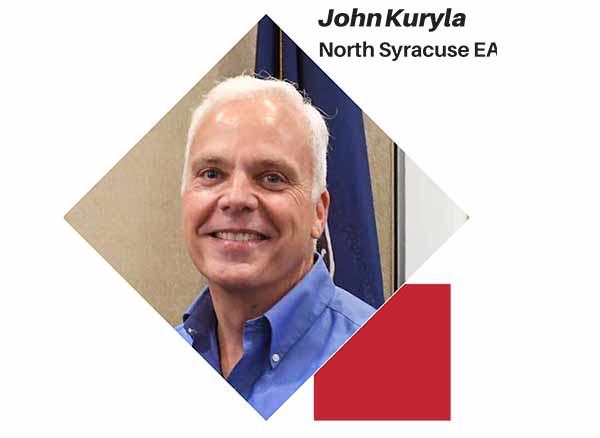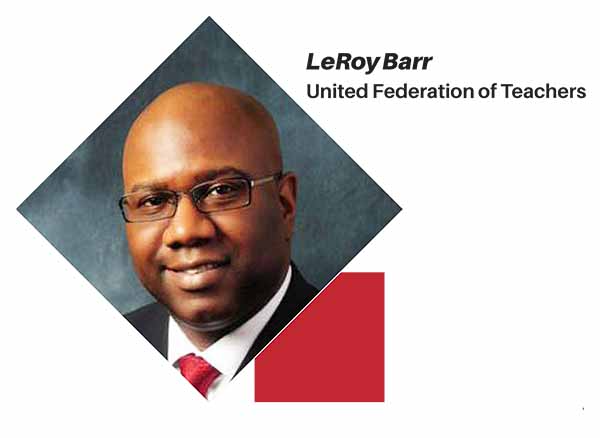Our public schools have always been places where parents, educators and community members come together to ensure that every child has the right to learn in a safe, secure and welcoming environment.
And as children head back to school this fall, the safety of students and our schools is at the forefront of everyone’s minds. We must stand up together — educators, parents and community members — to support a public education system that meets the needs of every student. That includes offering a helping hand to students still reeling from the impact of academic disruption due to the pandemic.
While educators, parents, students and administrators long for a return to normal, in many instances, our public schools simply aren’t the safe places they should be. Violent classroom episodes and the threat of mass violence in schools are an all-too-common reality. And, after years of underfunding, many schools lack the staff to help students emotionally cope with the challenges they face. However, there is hope.
“The goal of NYSUT’s Safe Schools for All Task Force, made up of educators from across our state, is to put together a list of recommendations for national, state and local leaders to best support safe public schools at the heart of every community,” said NYSUT President Andy Pallotta.
Specific recommendations will be fully released in a report this fall. The report focuses on four key goals:
1. Addressing social-emotional needs of students
School safety is more than being prepared for emergencies; it’s a day-to-day concern that should be addressed proactively. Schools must address behaviors caused by trauma and mental health issues through practices such as therapeutic crisis interventions for schools, restorative justice practices and social-emotional learning. Mental health training and mental health programs should be extended to all school staff to ensure that everyone has the resources they need to help students succeed.
2. Ensuring appropriate staffing levels
Student learning environments suffer when buildings are thinly staffed. New York state must establish safe staffing ratios for school social workers, counselors and psychologists to support students’ needs. Districts should also reduce class sizes and hire staff dedicated to coordinating and supporting student safety needs.
3. Fostering community partnerships
Schools are a reflection of the overall health, safety and well-being of the community. That’s why it’s important to improve communication with all stakeholders in the school community. School safety committees should include parent groups, educators and community members. This includes partnering with local unions to strengthen the implementation of safety initiatives. Schools should guarantee the accurate and consistent reporting of school safety incidents in order to build trust among students, staff and parents and improve the effectiveness of school safety measures.
4. Keeping students and staff safe from threats
Previous recommendations focused on supporting the whole child to make schools safer, but we must also implement policies and practices to create safe learning and working environments. Educators face both day-to-day and once-in-a-lifetime threats, and local, state and national leaders must work to make school environments safer.
We hear the need for change from NYSUT members. We’ve printed some of their stories on the next few pages. We’ll feature others online and on social media. It’s time for the state and districts to support our hardworking students and educators by working collaboratively to maintain — and improve — school safety. Share your stories at nysut.org/safeschools.
Addressing social-emotional needs of students
Learning how to assess student needs

If you see something, say something. That was the takeaway for Dwayne Cerbone after attending a two-day summer training focused on student safety for mental health staff, union leaders, administrators and community parent groups. The Pittsford District Teachers Association president explained that intracommunity communication is important.
Organizations already engaged with a student or family can offer insight about concerning behaviors. And educators shouldn’t silo student observations, but “have conversations with each other, with student families, and be observant about what’s going on.”
The PDTA will use union and faculty meetings and other staff trainings to share workshop strategies.
“An English or PE teacher might see something minor, but until they share it with others we can’t assess if a student needs help. Instead of waiting for students to let us know they need help, we want to encourage the adults working with them to communicate their observations. ”
Ensuring appropriate staffing levels
Staff shortages impact school safety

Yonkers City schools have long struggled with limited staff, but the pandemic and a severe lack of substitutes have kicked the problem up another notch, said high school special education teacher Dena DeLucia–Pryzgoda.
Similar to safety measures in place at day care centers, she suggested the state should enforce minimum staffing ratios for all public schools. To help fill in staffing gaps, the longtime Yonkers Federation of Teachers member said every school should have three to five permanent building subs to cover classes and other places as needed.
“It shouldn’t be about money. It should be about safety first.”
“ If you have seven teachers out at the high school — but only two subs — that means five classes are combined in the auditorium. That’s 150 kids with maybe five staffers. Definitely not a good situation. ”
Fostering community partnerships
Collaborating to keep kids safe

The Cicero-North Syracuse High School community was devastated when two district students died by suicide. In collaboration with the union, the district acted swiftly to provide therapeutic care, explained North Syracuse Education Association President John Kuryla, by partnering with local nonprofit Contact Community Services to implement “Suicide Safety in School.” The program provides crisis and mental health training for district staff, parents and students.
The district also partnered with a community-based health organization to supplement its staff of school counselors and social workers. Organization staff met with children one-on-one and in small groups and were onhand to greet students daily.
“These mental health checks let students know they’re connected and that someone is looking out for them. The partnership between the health nonprofit and the district has been well-received by the community and by the schools. The kids just gravitate toward them. ”
Keeping students and staff safe from threats
Training is vital for all staff

Attendance clerk Tanya Truesdell handles the single point of entry at the Edwards-Knox Central School District building in St.Lawrence County. She decides who’s admitted to the building and manually locks it down in an emergency.
After 10 years on the job, security has improved.
The district employs a security officer, and a door and walls have replaced the open desk by the front entrance she manned her first two years. Still, Truesdell, secretary of the Edwards-Knox Service Employees Association, welcomes formal training, calling an end-ofyear active shooter drill “eye opening.”
Truesdell requested inclusion on a building safety committee composed of the school’s security officer and administrators.
Collaboration supports students and educators

Supporting students’ social-emotional needs is the best way to prevent crises in our schools. Relying solely on punitive measures only harms students in the long run and exacerbates the very problems we are seeking to solve. Watering down the school code of conduct doesn’t work either. Successful programs bring together all the people in the school building to find solutions and make sure there is buy-in by all stakeholders.
The United Federation of Teachers, led by Michael Mulgrew, and the New York City Department of Education developed the Positive Learning Collaborative, which partners with educators and administrators to provide the training, tools and support needed to ensure every school is a nurturing, joyful place to learn and grow.
“We needed to do something different,” said LeRoy Barr, UFT secretary and staff director. “Everyone is on the same page, their voices are valued, and we share accountability for our success. ” The PLC behavior specialist team is a group of public school educators with backgrounds in social work, psychology, special education, restorative practices and social justice. All school stakeholders receive intense training and direct consultation with experts. Teachers learn techniques to help avoid conflicts, and keep those that do occur from escalating. Additional training and support is brought in to prevent bias-based bullying and promote gender-inclusive schools. The Positive Learning Collaborative has been implemented in large and small public schools in 22 communities across all five boroughs of the city.
The PLC’s successes speak for themselves. In one case study, school staff reported a 50 percent reduction in suspensions, 32 percent increase in staff’s ability to manage challenging behavior, 33 percent increase in open communication and an 85 percent increase in staff feeling valued. Learn more at positivelearning.org.
School violence prevention tips
NYSUT’s Safe Schools for All report provides a road map for how our union will advocate for safer schools from the district level to the highest levels of government. But creating safer schools also requires local buy-in and work, from the school bus to the classroom to the lunchroom.
NYSUT is in the process of rolling out a Safe Schools for All toolkit and training session for local union leaders with steps that lead to safer learning environments in every district. While this work is best done with trained NYSUT staff who can facilitate the transformational change needed in so many places, it’s also critical that individual members are empowered to take charge of safety in the spaces they work.
The following simple steps are just the first you can take to empower yourself as an education professional to foster a safer environment for students, staff and families alike:
Know your district or union incident reporting protocols
Check with your local union reps on how classroom safety incidents should be logged and reported. If your local union has clear definitions and terms, as well as any tools, to use when reporting incidents, be sure you’re consistent with those procedures.
Seek out training
It’s critical that districts offer routine training on safety procedures and protocols, as well as about strategies for helping address student behaviors. Where districts fall short, NYSUT ELT offers an array of professional learning options, including sessions currently ongoing on handling violent incidents, bullying, restorative practices and engaging with and winning over challenging students. For more information, contact elt@nysut.org or call 800-528-6208.
And visit nysut.cc/behavior for more on de-escalating challenging behaviors.
Take action
Districts are required by law to have a School Safety Committee, under the requirements of the Safe Schools Against Violence in Education law. Check with your local union on how you can lend your voice and get involved in your district’s school safety initiatives.
Maintain communication
Don’t assume you’re alone in dealing with disruptive student behaviors or safety incidents in your classroom. Communicate with your colleagues and local union representatives regularly.
Use your union’s collective voice to elevate concerns.
Visit nysut.org/safeschools for information and for stories, including several videos of NYSUT members talking about their experiences.